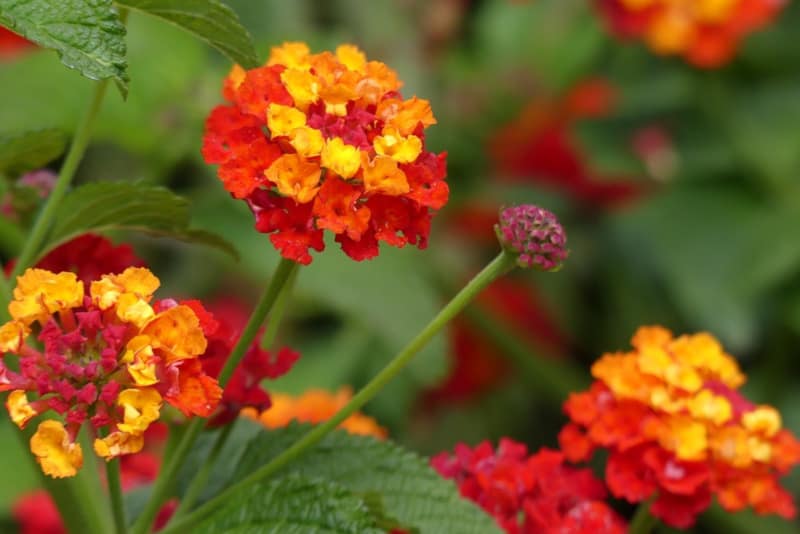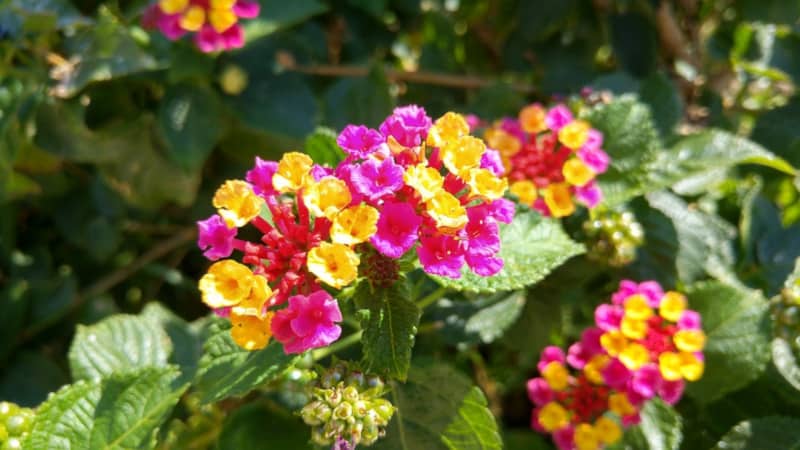Lantana Facts
- Firstly, the simple term of Lantana actually serves as the collective name of a large family of stunning flowering plants. Furthermore, the family currently contains roughly 150 officially recognized species. Also worthy of note remains the fact that all of these lovely plants classify as perennials.
- Perhaps most notably, the members of the large group all evolved in a certain portion of the world. For so many related species to develop in such a close association remains quite uncommon. Human actions have, however, now introduced many of the fascinating plants to other regions of the world.
- Regrettably, though, certain varieties of Lantana evolved as quite invasive in nature. This occurs as direct side effect of the fact that most members of the lovely group of plants spread very rapidly. In point of fact, many experts rate the natural growth rate of these species as absolutely remarkable.
- Further, the leaves of all recognized types of Lantana remain extremely toxic to most animals, But, a few creatures possess immunity to its toxins. Further, one of the few mammals capable of feeding upon them is the Swamp Wallaby. Animal foraging, therefore, does not slow the spreading of the seeds.
- Finally, given that the term applies to so many different species, conservation statuses naturally differ. Fortunately, though, for the moment, only a few species appear on the IUCN Red List. Nonetheless, like many other species around the world, many of them can be considered to be at risk due to climate change.
Related Articles
Lantana Physical Description
Most impressively, and quite distinctively, the various forms of Lantana developed a very remarkable trait. That fact holds true because the comparatively large genus includes both shrubs and trees. So quite naturally, physical appearances and descriptions can vary somewhat significantly among species.
Nevertheless, however, certain physiological factors do remain constant. Firstly, these herbaceous plants attain a certain range of heights. More precisely, this range extends from 1.6 – 6.6 ft (0.5-2 m) in overall height. These Angiosperms also develop in a variety of colors which include bright orange, red, yellow, white, and blue.
Further, and interestingly, the blooms of the gorgeous Lantana themselves present a most unusual characteristic. That’s because these blossoms most commonly change color as they mature. As a result of this unusual pattern, the inflorescences often display two or sometimes even three different colors simultaneously.
- Kingdom: Plantae
- Phylum: Angiosperms
- Class: Eudicots
- Order: Lamiales
- Family: Verbenaceae
- Genus: Lantana
Lantana Distribution, Habitat, and Ecology
First of all, the various forms of the magnificent Lantana developed across three separate continents. Firstly, many of the different forms of the marvelous Angiosperm evolved as endemic to the continent of Africa. Secondly, however, the rest of the recognized members of this beautiful genus developed naturally in the more tropical regions of North America and South America.
Yet this fabulous grouping of plants has yet more characteristics to amaze those who learn of it. That occurs partly because, given its extremely wide distribution, the truly remarkable genus therefore successfully thrives in a comparatively wide variety of habitat types. But, the vast majority of these habitats typically consist of temperate forests, coastal regions, tropical forests, and also mountainous regions.
Also, some birds prefer to use the flower in decorating their nests. In these species, the male who provides the most colorful nest ranks as the one most suitable for mating. Therefore, the dazzlingly colorful Lantana constitutes a plant valuable to the preservation of several bird species. Finally, many types of birds consider the fruits to be a delicacy. So, naturally, these feed on the fruit and spread the seeds.
Species Sharing Its Range
Check out our other articles on 8 Swoon-Worthy Caves, Black Rain Frog, Brazilian Wandering Spider, Hawksbill Sea Turtle, Indian Giant Squirrel, Galapagos Penguin, Abronia macrocarpa


